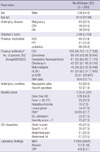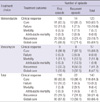1. Kelly CP, LaMont JT. Clostridium difficile: more difficult than ever. N Engl J Med. 2008. 359:1932–1940.
2. Pépin J, Valiquette L, Alary ME, Villemure P, Pelletier A, Forget K, Pépin K, Chouinard D. Clostridium difficile-associated diarrhea in a region of Quebec from 1991 to 2003: a changing pattern of disease severity. CMAJ. 2004. 171:466–472.
3. Lee YJ, Choi MG, Lim CH, Jung WR, Cho HS, Sung HY, Nam KW, Chang JH, Cho YK, Park JM, Kim SW, Chung IS. Change of Clostridium difficile colitis during recent 10 years in Korea. Korean J Gastroenterol. 2010. 55:169–174.
4. Shin BM, Kuak EY, Yoo HM, Kim EC, Lee K, Kang JO, Whang DH, Shin JH. Multicentre study of the prevalence of toxigenic Clostridium difficile in Korea: results of a retrospective study 2000-2005. J Med Microbiol. 2008. 57:697–701.
5. McFarland LV. Epidemiology, risk factors and treatments for antibiotic-associated diarrhea. Dig Dis. 1998. 16:292–307.
6. Gravel D, Miller M, Simor A, Taylor G, Gardam M, McGeer A, Hutchinson J, Moore D, Kelly S, Boyd D, Mulvey M. Canadian Nosocomial Infection Surveillance Program. Health care-associated Clostridium difficile infection in adults admitted to acute care hospitals in Canada: a Canadian Nosocomial Infection Surveillance Program Study. Clin Infect Dis. 2009. 48:568–576.
7. O'Connor JR, Johnson S, Gerding DN. Clostridium difficile infection caused by the epidemic BI/NAP1/027 strain. Gastroenterology. 2009. 136:1913–1924.
8. The anatomical therapeutic chemical (ATC) and defined daily dosing (DDD) system index 2010. World Health Organisation. accessed on 28 Oct 2010. Available at:
http://www.whocc.no/.
9. Zar FA, Bakkanagari SR, Moorthi KM, Davis MB. A comparison of vancomycin and metronidazole for the treatment of Clostridium difficile-associated diarrhea, stratified by disease severity. Clin Infect Dis. 2007. 45:302–307.
10. Louie T, Miller M, Donskey C, Mullane K, Goldstein EJ. Clinical outcomes, safety, and pharmacokinetics of OPT-80 in a phase 2 trial with patients with Clostridium difficile infection. Antimicrob Agents Chemother. 2009. 53:223–228.
11. Barbut F, Richard A, Hamadi K, Chomette V, Burghoffer B, Petit JC. Epidemiology of recurrences or reinfections of Clostridium difficile-associated diarrhea. J Clin Microbiol. 2000. 38:2386–2388.
12. Aspinall ST, Hutchinson DN. New selective medium for isolating Clostridium difficile from faeces. J Clin Pathol. 1992. 45:812–814.
13. Persson S, Torpdahl M, Olsen KE. New multiplex PCR method for the detection of Clostridium difficile toxin A (tcdA) and toxin B (tcdB) and the binary toxin (cdtA/cdtB) genes applied to a Danish strain collection. Clin Microbiol Infect. 2008. 14:1057–1064.
14. Rupnik M, Braun V, Soehn F, Janc M, Hofstetter M, Laufenberg-Feldmann R, von Eichel-Streiber C. Characterization of polymorphisms in the toxin A and B genes of Clostridium difficile. FEMS Microbiol Lett. 1997. 148:197–202.
15. Tae CH, Jung SA, Song HJ, Kim SE, Choi HJ, Lee M, Hwang Y, Kim H, Lee K. The first case of antibiotic-associated colitis by Clostridium difficile PCR ribotype 027 in Korea. J Korean Med Sci. 2009. 24:520–524.
16. Lee JH, Lee SY, Kim YS, Park SW, Jo SY, Ryu SH, Lee JH, Moon JS, Whang DH, Shin BM. The incidence and clinical features of Clostridium difficile infection; single center study. Korean J Gastroenterol. 2010. 55:175–182.
17. Byun TJ, Han DS, Ahn SB, Cho HS, Kim TY, Eun CS, Jeon YC, Sohn JH, Kang JO. Clinical characteristics and changing epidemiology of Clostridium difficile-associated disease (CDAD). Korean J Gastroenterol. 2009. 54:13–19.
18. Jung KS, Park JJ, Chon YE, Jung ES, Lee HJ, Jang HW, Lee KJ, Lee SH, Moon CM, Lee JH, Shin JK, Jeon SM, Hong SP, Kim TI, Kim WH, Cheon JH. Risk factors for treatment failure and recurrence after metronidazole treatment for Clostridium difficile-associated diarrhea. Gut Liver. 2010. 4:332–337.
19. Cheong HS, Kim JK, Kwon KT, Ryu SY, Heo ST, Ko KS, Oh WS, Peck KR, Lee NY, Song JH. Therapeutic efficacy of metronidazole for patients with Clostridium difficile-associated diarrhea. Korean J Med. 2007. 72:639–646.
20. Belmares J, Johnson S, Parada JP, Olson MM, Clabots CR, Bettin KM, Peterson LR, Gerding DN. Molecular epidemiology of Clostridium difficile over the course of 10 years in a tertiary care hospital. Clin Infect Dis. 2009. 49:1141–1147.
21. Barbut F, Gariazzo B, Bonné L, Lalande V, Burghoffer B, Luiuz R, Petit JC. Clinical features of Clostridium difficile-associated infections and molecular characterization of strains: results of a retrospective study, 2000-2004. Infect Control Hosp Epidemiol. 2007. 28:131–139.
22. Riggs MM, Sethi AK, Zabarsky TF, Eckstein EC, Jump RL, Donskey CJ. Asymptomatic carriers are a potential source for transmission of epidemic and nonepidemic Clostridium difficile strains among long-term care facility residents. Clin Infect Dis. 2007. 45:992–998.
23. Kyne L, Warny M, Qamar A, Kelly CP. Asymptomatic carriage of Clostridium difficile and serum levels of IgG antibody against toxin A. N Engl J Med. 2000. 342:390–397.
24. Kim H, Jeong SH, Roh KH, Hong SG, Kim JW, Shin MG, Kim MN, Shin HB, Uh Y, Lee H, Lee K. Investigation of toxin gene diversity, molecular epidemiology, and antimicrobial resistance of Clostridium difficile isolated from 12 hospitals in South Korea. Korean J Lab Med. 2010. 30:491–497.
25. Kim H, Riley TV, Kim M, Kim CK, Yong D, Lee K, Chong Y, Park JW. Increasing prevalence of toxin A-negative, toxin B-positive isolates of Clostridium difficile in Korea: impact on laboratory diagnosis. J Clin Microbiol. 2008. 46:1116–1117.
26. Iwashima Y, Nakamura A, Kato H, Wakimoto Y, Wakiyama N, Kaji C, Ueda R. A retrospective study of the epidemiology of Clostridium difficile infection at a University Hospital in Japan: genotypic features of the isolates and clinical characteristics of the patients. J Infect Chemother. 2010. 16:329–333.
27. Huang H, Wu S, Wang M, Zhang Y, Fang H, Palmgren AC, Weintraub A, Nord CE. Clostridium difficile infections in a Shanghai hospital: antimicrobial resistance, toxin profiles and ribotypes. Int J Antimicrob Agents. 2009. 33:339–342.
28. Elliott B, Squire MM, Thean S, Chang BJ, Brazier JS, Rupnik M, Riley TV. New types of toxin A-negative, toxin B-positive strains among clinical isolates of Clostridium difficile in Australia. J Med Microbiol. 2011. 60:1108–1111.
29. Huang H, Fang H, Weintraub A, Nord CE. Distinct ribotypes and rates of antimicrobial drug resistance in Clostridium difficile from Shanghai and Stockholm. Clin Microbiol Infect. 2009. 15:1170–1173.
30. Pépin J, Saheb N, Coulombe MA, Alary ME, Corriveau MP, Authier S, Leblanc M, Rivard G, Bettez M, Primeau V, Nguyen M, Jacob CE, Lanthier L. Emergence of fluoroquinolones as the predominant risk factor for Clostridium difficile-associated diarrhea: a cohort study during an epidemic in Quebec. Clin Infect Dis. 2005. 41:1254–1260.






 PDF
PDF ePub
ePub Citation
Citation Print
Print






 XML Download
XML Download